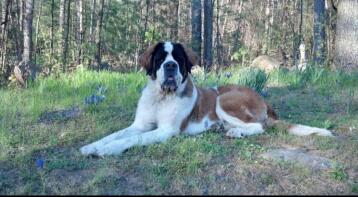Saint Bernard Dogs





Breed Rating (2 Reviews)
| Appearance | |
| Friendliness | |
| Hardiness | |
| Garden |
History
The first record of this breed dates back to 1707 from the monks of Saint Bernard Pass Hospice between Switzerland and Italy. This large breed most likely is descended from the Roman Molossian dogs. They are renowned for their live saving abilities. They were used to help pull carts and turn spits, though monks soon found out that they had a seemingly built-in ability to find and rescue lost travelers even in the deepest of snow. Interestingly enough, they were never trained in these live-saving abilities and younger dogs simply learnt from older ones.
Behaviour
The Saint Bernard is devoted to its family and is excellent with children. They know how children act and are very gentle with them, even moving out of the way to avoid knocking them over. They are hyper and over-excitable as puppies, but they grow up into a much more placid and laid back dog. As is the case with all large breeds, training needs to be started early on and should be consistent.
Saint Bernards aren’t the easiest dogs to train and can be stubborn at times, but they do learn and will enjoy the chance to keep their brains active. Training has to be assertive to prevent the dog from taking over. This is a very friendly breed, but they need to be well socialised to avoid any problems. In terms of exercise, St. Bernards will need a long walk each day, mainly to keep their minds active. Actually getting them outside can be a chore sometimes as this breed is prone to laziness and would probably much rather sit around on the couch all day.
Saint Bernards are not at all aggressive, being a kind and good natured breed at heart, but their sheer size is enough to scare away any intruders. They make for a good watchdog and will bark when something’s up. You will need a tall fence in your garden to prevent your dog from taking part in any solo-adventures around the block.
Their coats can get rather long and will require a good amount of grooming. Brushing is needed at least 3 times a week. The Saint Bernard can overheat quickly in the summer months, so be sure to provide them with a cool place to rest and only take them out in the mornings or evenings when it is cooler. They drool a lot.
Temperament
Saint Bernards are loyal, steadfast and easygoing. They are calm, patient and love their human family. They tend towards laziness and owners have to encourage them to get sufficient exercise. Saint Bernards love companionship and will often lean against you or sit on your feet. Generally they are chilled out in terms of meeting new people or other dogs, but not particularly playful as a breed.
Health Problems
The large size of this dog makes it prone to Canine Hip Dysplasia. These dogs grow remarkably quickly and it is important to provide them with a balanced and quality diet whilst they are growing up to prevent issues later on in their lives. They may also be prone to elbow dysplasia, luxating patella (dislocation of the knee cap), other orthopedic disease, epilepsy, bloat, cancer, allergies, blood clotting disease and eye problems.
Breed Details
- Status: Common
- Life Expectancy: 8 - 10 years
- Weight: 140 - 265 lbs
- Height: 28 - 35"
- Rare: No
- Coat: Short
- Grooming Requirements: More than once per week
- Town or Country: Either
- Minimum Home Size: Large House
- Minimum Garden Size: Small to Medium Garden
- Breed Type: Working Dog
- Size: Giant
- Energy Level: Low
- Exercise Required: Up to 1 hour
Saint Bernard Pictures

Latest Reviews For Saint Bernard (2 of 2)
Ratings are WRONG - Mike,
The stars don’t make sense: Saints are majestic, amazingly friendly and great with kids, and durable as they come. They are designed to help people and love being around humans and other dogs. They are not, however, great on your yard
Incredibly intelligent and amazing - Omar,
Zak was incredibly intelligent, amazing, and always will be missed xxx








